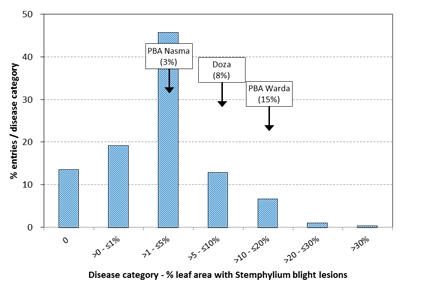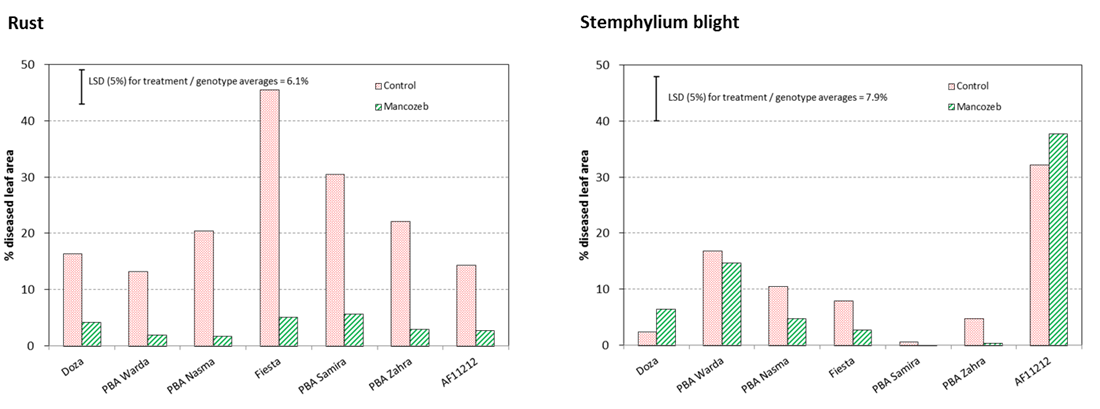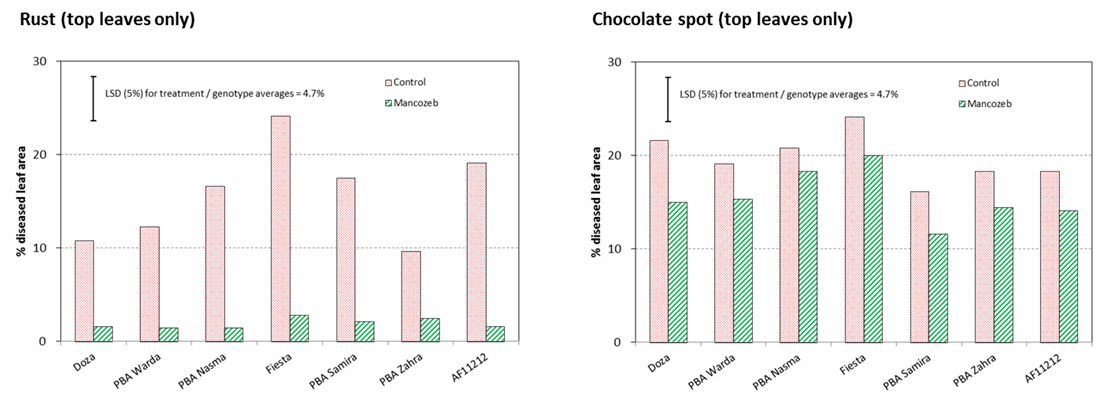Faba bean disease management update
Author: Joop van Leur (NSW DPI Tamworth), Bill Manning (Local Land Services, Gunnedah) and Sue Thompson (University of Southern Queensland, Toowoomba) | Date: 27 Feb 2017
Take home messages
- The high rainfall during the 2016 growing season favoured development of leaf blights in faba bean in the northern grain region.
- By mid-August severe incidences of chocolate spot (Botrytis fabae) were found throughout the northern region, particularly in early sown crops. Timely fungicide applications were able to control disease development in most cases.
- High incidences of uncommon leaf blight symptoms were noted at several sites in NSW and Queensland. The disease was identified as Stemphylium blight, caused by generally saprophytic Stemphylium spp. Evaluation of disease screening nurseries sown at the NSW DPI Liverpool Plains Field Station (LPFS) showed a wide range in susceptibility in the faba bean germplasm pool, with the recently released variety PBA Warda among the more susceptible genotypes. Currently little information is available on crop losses or management options. However, initial research indicates that the disease would only cause problems in very wet years.
- Trials at LPFS showed substantial yield gains from foliar disease management after fungicide applications, even on the newest, more disease resistant, varieties.
- Only low incidences of rust (Uromyces viciae-fabae) were reported in commercial fields of faba bean. This is likely the result of the frequent fungicide applications used to control leaf blights.
- The dry 2015-2016 summer and the wet 2016 winter season reduced aphid populations resulting in the near absence or viruses in northern faba bean crops.
- Following the wet 2016 season, inoculum loads of residue-borne diseases (chocolate spot, Ascochyta blight, rust and – likely – Stemphylium blight) will be high at the start of the 2017 season. Growers are advised to adhere to the recommended disease management strategy for faba bean diseases. Especially important will be the early (6 – 8 leaves) fungicide application. Mancozeb is still the recommended product for the first application, because of its broad spectrum and absence of restrictions on number of applications.
Development of faba bean diseases in the 2016 season
Among the winter pulses, faba bean is the preferred cropping option in the high rainfall zones and for soils that are prone to water logging. However, high rainfall seasons also provide an environment that is favourable for the development of fungal pathogens. Both rust (Uromyces viciae-fabae) and chocolate spot (Botrytis fabae) have caused significant yield losses over the past years in faba bean in the northern grain region. While rust can be observed in most seasons (even in those with relatively low rainfall), incidences are generally kept below critical levels by the improved resistance in new varieties and by timely fungicide applications. Chocolate spot is typically only of importance during wet seasons, but has then the potential to cause complete crop failure in a few days. Chocolate spot has a very short latent period (1-3 days compared to at least 10 days for rust) and unlike the obligate rust pathogen, the necrotrophic chocolate spot pathogen grows and sporulates on senescent and dead leaf tissue, thereby massively increasing inoculum loads in the crop. While new faba bean varieties released for the northern region have increased levels of rust resistance, less progress has been made in combining improved chocolate spot resistance with local adaptation.
Proper control of foliar diseases requires timely application of appropriate fungicides when the disease is detected and rainfall events are predicted. Proper diagnosis of the disease is of crucial importance, eg early symptoms of chocolate spot (brown pin-point lesions) can be confused with symptoms caused by spray oils or abiotic stresses or by symptoms caused by other leaf blights.
Fungicide options in faba bean are currently limited. Mancozeb is often the preferred product because of its broad action and the absence of limits on usage frequency. Carbendazim and procymidone are reported to be better options for chocolate spot control, but our fungicide efficacy trials over the past season (results not reported here) showed that both chemistries have no effect on rust development. The same trials showed efficacy of chlorothalonil on both rust and chocolate spot and a superior control of rust by tebuconazole. Use of tebuconazole on faba bean is currently on permit, but restricted to a maximum of three spray treatments per season, at an interval of 14 – 21 days between consecutive sprays. (Permit no: 13752).
Based on our surveys and on samples submitted by growers and agronomists, the important diseases during the 2016 were chocolate spot and (to a lesser extent) Stemphylium blight (see below). Rust was found in very few commercial faba bean crops and did not develop to levels that limited yield. No other leaf blights, like Ascochyta blight or Cercospora leaf spot, were identified. Climatic conditions did not favour aphid development or movement; consequently viruses did not play a role in the 2016 season.
Stemphylium blight
Symptomatology, losses and control options
Unusually high incidences of leaf blight symptoms were observed on faba bean during the 2016 growing season. The symptoms were identified as Stemphylium blight (StB), a disease known to affect lupins and lentils, but rarely reported in faba bean. Several Stemphylium species have been reported as the causal agent in lupins and lentils. Species identity of faba bean isolates from different locations in NSW and Queensland is currently being determined by USQ and QDAF using molecular tools.
Early in the season Stemphylium blight was frequently misdiagnosed by growers and advisors as chocolate spot and symptoms can at times be confusing. However, chocolate spot typically starts as small discrete reddish-brown leaf lesions that after extended periods of leaf wetness increase rapidly in size, move to other plant parts and cause severe leaf necrosis, stem collapse and flower and pod abortion. Stemphylium blight is characterised by large grey-black necrotic lesions, often starting from the leaf edge and restricted to leaves and, to a lesser extent, stems. No symptoms were noted on flowers or pods.
Little is currently known about the effect of StB on faba bean yields. However, high incidences on individual plants could be noted in early August, which would have the potential to reduce yields. A preliminary yield loss estimate was made using the varieties PBA Nasma and PBA Warda grown in non-fungicide treated plots at LPFS. On 12 August in each of three plots of each variety, 10 severely (>25 % affected leaf area) blighted branches were labelled as well as a neighbouring unaffected branch. The 120 labelled branches (30 severely affected and 30 non-affected of each variety) were individually harvested and yield parameters measured. Number of pods, number of seeds and seed weight of affected branches was reduced to half of that of non-affected branches (Table 1). These figures are indicative only and likely to represent a ‘worst case’ scenario, as faba bean can generally compensate early damage by increased branching of neighbouring non-affected plants.
Table 1. Comparison of severely Stemphylium blight affected (s/a) and non-affected (n/a) branches of two varieties grown in non-fungicide treated plots at the Liverpool Plains Field Station, 2016.
|
|
Pods / branch |
Seeds / branch |
Seed weight (g) / branch |
|||
|
|
n/a |
s/a |
n/a |
s/a |
n/a |
s/a |
|
PBA Warda |
13 |
7 |
33 |
17 |
21 |
11 |
|
PBA Nasma |
10 |
4 |
23 |
10 |
18 |
7 |
No information is as yet available on the efficacy of fungicides for the control of Stemphylium blight on faba beans, lentils or lupins. Our initial results (not reported here) indicate that out of the currently registered fungicides, the application of tebuconazole resulted in lower incidences, but further trials are necessary before reliable recommendations can be made and tebuconazole is not registered for the control of Stemphylium blight in faba beans.

Figure 1. Distribution of 443 faba bean genotypes over Stemphylium blight scoring classes, with %leaf ratings for three current varieries seperately listed, Liverpool Plains Field Station, 10 August 2016
Varietal differences
The evaluation of 443 faba bean genotypes in the disease screening nursery at LPFS showed a non-symmetrical distribution over Stemphylium blight incidence classes, with only 37 entries showing more than 10% blight severity (Fig. 2). The recently (2012) released variety PBA Warda (now the most widely grown variety in the northern region) was among the more affected (15% severity), while PBA Nasma and Doza, the other two widely grown varieties in the northern region, had lower levels of infection.
Distribution of the disease within and between plots pointed to a high degree of genetic control. Greenhouse screening tests are ongoing, but initial results confirmed the very large differences in Stemphylium resistance observed in the field among as well as within breeding lines. Clear differences among single plant progenies taken from inbred lines indicate that the resistance is based on a single gene or only a few genes. This is unusual for a saprophytic pathogen, but a similar basis of resistance is operating in the narrow-leaf lupin gene pool against the grey leaf spot disease, which is also caused by a Stemphylium spp.
Conclusions
The appearance of Stemphylium blight during the 2016 season is most likely a combination of a very wet season and the growing of a susceptible variety. While the disease will have caused yield losses in severely affected sites, the confusion of Stemphylium blight symptoms with those of other leaf blights (particularly chocolate spot), resulted in unnecessary fungicide applications.
Resistance screening trials are continuing to eliminate from the breeding program highly Stemphylium blight susceptible genotypes. Fungicide efficacy trials are planned for the 2017 season that would allow better recommendations for control as well as providing yield loss data.
Disease tolerance trials
A set of 12 faba bean genotypes, consisting of 6 widely grown varieties (in both the southern and northern region) and 6 advanced breeding lines was tested for tolerance to rust and other diseases at the Liverpool Plains Field Station (LPFS). A split plot design was used with fungicide treatment vs untreated control as the main plots, genotypes as subplots, 3 replicates and a plot size of 15m2. The trial was located close to the rust inoculated disease screening nursery which provided a heavy rust inoculum load throughout the season.
Fungicide (mancozeb 750 g ai / kg product, applied at 1 kg product / ha) was applied 4 times prior to predicted significant rain events (Figure 1).

Figure 2. Liverpool Plains Field Station, 2016. Weekly rainfall, weekly hours leaf wetness, timing of fungicide applications
Disease severity (% leaf area affected) was determined on a plot basis by taking the average of two estimates taken on the centre plot row 1 m from the plot edge on both sides of the plot. Figures 2-4 summarise disease readings and yield components of the 6 released varieties and a highly Stemphylium blight susceptible breeding line.
Rust development started early in the season and high rust incidences were noted, particularly on the rust susceptible variety Fiesta. Disease severity readings on 10 August showed a large reduction of rust following the fungicide applications, but no effect of mancozeb on Stemphylium blight (Figure 2). The large differences in Stemphylium blight severity observed among genotypes in the LPFS disease screening trial was also evident in this trial with the breeding line AF11212 showing a very high degree of susceptibility.

Figure 3. Faba bean disease tolerance trial, Liverpool Plains Field Station, 2016. Rust and Stemphylium blight severity (% leaf area affected) on 10 August.
Later in the season Stemphylium blight symptoms remained largely at the base of the plants and did not progress to younger leaves. High rainfall during the second half of August and early September favoured further spread of rust and, especially, a rapid development of chocolate spot. Mancozeb applications kept rust at low levels, but control of chocolate spot was unsatisfactory (Figure 3).

Figure 4. Faba bean disease tolerance trial, Liverpool Plains Field Station, 2016. Rust and chocolate spot severity (% leaf area affected) on 27 September.
Averaged over the 7 entries, the fungicide applications resulted in a 65% increase of yield. The largest increase in yield was on the highly rust susceptible variety Fiesta, but - surprisingly - significant yield gains were as well recorded on varieties with a high level of rust resistance like Doza, PBA Warda and PBA Zahra. No effect of the fungicide application on seed weight was evident. It is interesting to note that the advanced breeding line AF11212, which was severely affected by Stemphylium blight early in the season, ended as one of the better yielders of the trial with and without fungicide application. Proper Stemphylium blight yield loss experiments are needed before definitive statements can be made, but this could indicate that early infection by Stemphylium blight may not have a large impact on final grain yield.

Figure 5. Faba bean disease tolerance trial, Liverpool Plains Field Station, 2016. Grain yield and seed weight.
Acknowledgements
The reported research was made possible by the significant contributions of growers through their involvement in disease surveys and submitting of samples and their support of the GRDC. The authors would like to thank them for their continued support. We also acknowledge the faba bean pathology team at the Tamworth Agricultural Institute (Jule George, Stuart Marshman, Merv Riley, Janine Sipple and Ivan Stace) for their enthusiastic technical support. We like to thank Raechelle Grams from the University of Southern Queensland and Yu Pei Tan of DAFQ for their ongoing work using molecular techniques to identify the causal Stemphylium species.
Contact details
Joop van Leur
NSW DPI
Ph: 0427 928 018
Email: joop.vanleur@dpi.nsw.gov.au
Bill Manning
North West Local Land Services
Ph: 0428 607 731
Email: william.manning@lls.nsw.gov.au
Sue Thompson
University of Southern Queensland
Ph: 0407 031 244
Email: sue.thompson@usq.edu.au
Was this page helpful?
YOUR FEEDBACK
